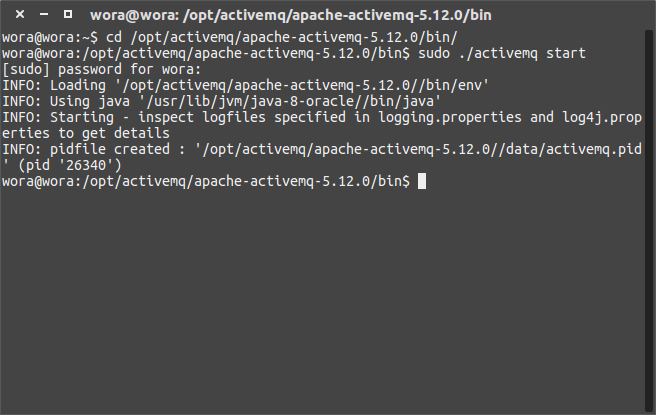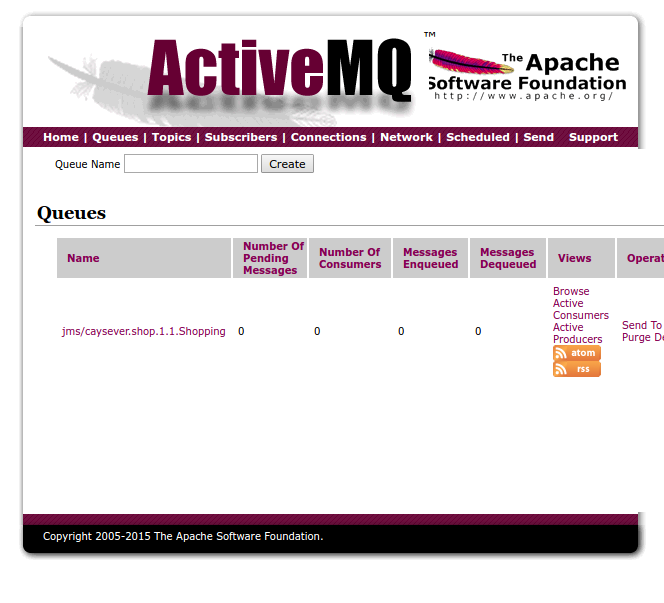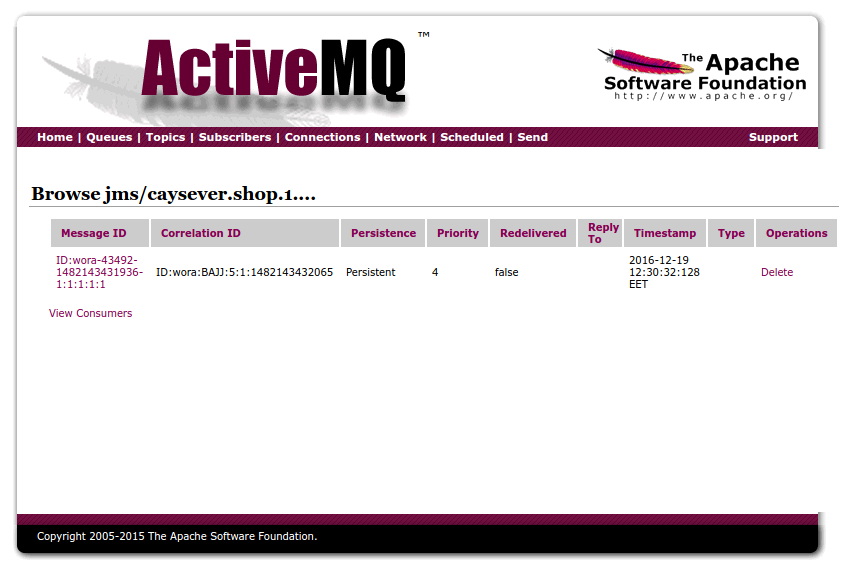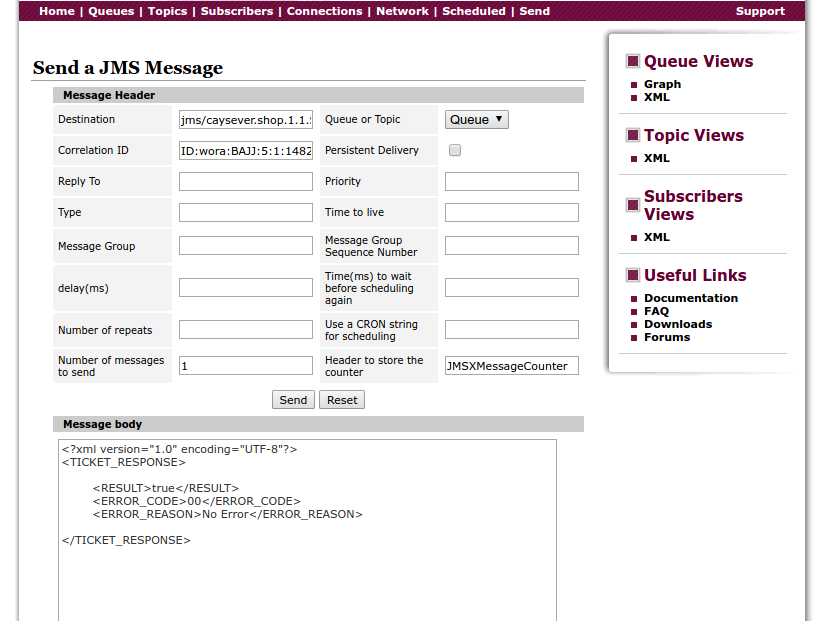Merhaba arkadaslar, bu yazımızda JMS vendor olarak ActiveMQ kullanarak örnek yapacağız.
ActıveMQ
Apache tarafından geliştirilen, open-source bir JMS implementasyonudur. Apache çatısı olması dolayısıla diğer Apache ürünleri ile benzer bir yapıdadır. Detaylı bilgiye şuradan erişebilirsiniz.
ActiveMQ’yu indirip default ayarlar ile çalıştıralım.

Browser’dan şu url’e gidelim -> http://localhost:8161/admin
Basic authantication ile login olalım, default olarak admin/admin ile giriş yapabilirz.

Web arayüzünden Queue/Topic oluşturabilir, Queue/Topic’deki mesajları görüntüleyebilir, mesaj vs gönderebilirsiniz.
Biz konumuza dönecek olursak; JMS için gerekli olan 2 adet bileşen vardır.
- Factory name : Vendor’un impelementasyonudur. Her vendor için farklıdır.
- Provider URL : Vendor’un JMS’i implemente edebilmesi için gereken config bilgileridir. Her vendor için farklıdır.
JMS bir abstraction ve/veya spec olduğu için alt vendorler ile çalışacağız. Burada MQ’ya bağlanabilmek için şu adımlar gerçekleşir.
- JMS’e şu factory için bir Connection ver diyeceğiz. Burada JMS bizim için vendor ile konuşup bize connection objesi verecektir.
- JMS’e connection alırken MQ bilgilerini nereden alacağını belirteceğimiz Provider URL(Broker URL’de denir) bilgisini vereceğiz.
- Total de elimizde MQ üzerinde bir connection olacaktır. Bir sonraki adım ise Queue veya Topic’lere bağlanmaktır.
ActiveMQ özelinde factory name ve default ayarlar şu şekilde;
- Factory name : org.apache.activemq.jndi.ActiveMQInitialContextFactory
- Provider URL : tcp://localhost:61616
- Connection Factory JNDI name : ConnectionFactory
- Queue JNDI name : dynamicQueues/{QueueName}
Default ayarları ActiveMQ/conf dizini altında bulabilirsiniz.
Yukarıda ifade edilecek şekilde bir MQ bağlantısı yaptığınız takdirde vendor bağımsız bir JMS çalışması yapmış olursunuz. Vendor, TibcoMQ, ActiveMQ, RabbitMQ, SonicMQ veya IBM MQ vs olabilir.
Provider url, bazı vendorler için tcp üzerinden erişilirken bazı vendorlerde ise IBM MQ gibi, Ldap provider url olabilir yada file systemde file binding olabilir. Birkaç örnek verelim;
- IBM WebSphere MQ için Factory name com.sun.jndi.ldap.LdapCtxFactory ise provider URL de **ldap://
** şeklinde olmalıdır. - IBM WebSphere MQ için Factory name com.sun.jndi.fscontext.RefFSContextFactory ise provider URL de **file:
** şeklinde olmalıdır. - ActiveMQ, SonicMQ için Provider URL -> tcp://host:port
- TibcoMQ için Provider URL -> tibjmsnaming://host:port şeklindedir.
Bir tane Queue oluşturalım;

Naming conventions olarak şu şekilde oluşturmak tavsiye edilir -> jms/mygroup.myproject.version.resource.queue
ActvieMQ ile çalışırken lib olarak şurayı kullanabiliriz; activemq all jar
Bir örnek yapalım;
Properties file’da aşağıdaki tanımları yapalım;
- jms.connection.factory.name -> org.apache.activemq.jndi.ActiveMQInitialContextFactory
- jms.provider.url -> tcp://localhost:61616
- connection.factory.jndi.name -> ConnectionFactory
- output.queue.name -> jms/caysever.shop.1.1.Shopping
- jms.message.timetolive -> 60
- jms.correlation.id.delimeter -> :
- jms.connection.username -> ”“
- jms.connection.password -> ”“
1
2
3
4
5
6
7
8
9
10
11
12
13
14
15
16
17
18
19
20
21
22
23
24
25
26
27
28
29
30
31
32
33
34
35
36
37
38
39
40
41
42
43
44
45
46
47
48
49
50
51
52
53
54
55
56
57
58
59
60
61
62
63
64
65
66
67
68
69
70
71
72
73
74
75
76
77
78
79
80
81
82
83
84
85
86
87
88
89
90
91
92
93
94
95
96
97
98
99
100
101
102
103
104
105
106
107
108
109
110
111
112
113
114
115
116
117
118
119
120
121
122
123
124
125
126
127
128
129
130
131
132
133
134
135
136
137
138
139
140
141
142
143
144
145
146
147
148
149
150
151
152
153
154
155
156
157
158
159
160
161
162
163
164
165
166
167
168
169
170
171
172
173
174
175
176
177
178
179
180
181
182
183
184
185
186
187
188
189
190
191
192
193
194
195
196
197
198
199
200
201
202
203
204
205
206
207
208
209
210
211
212
213
214
215
216
217
218
219
220
221
222
223
224
225
226
227
228
229
230
231
232
233
234
235
236
237
238
239
240
241
242
243
244
245
246
247
248
249
250
251
252
253
254
255
256
257
258
259
260
261
262
263
264
265
266
267
268
269
270
271
272
273
274
275
276
277
278
279
280
281
282
283
284
285
286
287
288
289
290
291
292
293
294
295
296
297
298
299
300
301
302
303
304
305
306
307
308
309
310
311
312
313
314
315
316
317
318
319
320
321
322
323
324
325
326
327
328
package com.caysever.jms.adaptors;
import java.net.InetAddress;
import java.text.SimpleDateFormat;
import java.util.Date;
import java.util.Hashtable;
import java.util.Locale;
import java.util.Properties;
import java.util.concurrent.ConcurrentHashMap;
import javax.jms.JMSException;
import javax.jms.Message;
import javax.jms.MessageProducer;
import javax.jms.Queue;
import javax.jms.QueueConnection;
import javax.jms.QueueConnectionFactory;
import javax.jms.QueueReceiver;
import javax.jms.QueueSession;
import javax.jms.Session;
import javax.naming.Context;
import javax.naming.InitialContext;
import org.apache.commons.lang3.StringUtils;
import org.apache.log4j.Logger;
import org.w3c.dom.Document;
import com.caysever.beans.JMSReplyResultBean;
import com.caysever.beans.MessageBean;
import com.caysever.jms.processor.JMSReplyProcessorFactory;
import com.caysever.jms.processor.ReplyProcessor;
public class JMSAdaptor {
private Logger logger = Logger.getLogger(JMSAdaptor.class);
private SimpleDateFormat fmt = new SimpleDateFormat("ddMMyyyy_hhmmss_S", Locale.ENGLISH);
private InitialContext initialContext;// jms factory alacagimiz context
private ReplyProcessor replyProcessor;
private ConcurrentHashMap<String, MessageBean> replyHoldMap = new ConcurrentHashMap<String, MessageBean>();
private QueueConnectionFactory connectionFactory;// queue connection factory
private QueueConnection connection;// queue connection icin
private Queue outputQueue;// mesajin export edilecegi queue
private Queue replyQueue;// cevabin alinacagi queue
private QueueReceiver replyQueueReceiver;// reply queue icin receiver
private QueueSession queueSession;// receiver icin session olusturma
private String jndiFactoryName;// vendor bagimsiz factory alabilmek icin
private String providerUrl;// provider url, url ve/veya file olabilir
//senkron sekilde calismak icin.
private long timeToLive;
// username&passsword var ise connection'a bunlari ekleyelim.
private String jmsUsername;// username
private String jmsPassword;// password
// ssl settings
private boolean sslEnabled = false;
private String keyStore;
private String keyStorePassword;
private String trustStore;
private String trustStorePassword;
// correlation id uretmede kullanilacak.
private String delimeter;
public void initialize(String adaptorPrefix, Properties appProps) {
try {
if (appProps != null) {
sslEnabled = PropertiesUtils.getBooleanProperty(appProps, adaptorPrefix + ".mq.ssl.enabled", false);
if (sslEnabled) {
logger.info("MQ ssl connection enabled.");
keyStore = PropertiesUtils.getStringProperty(appProps, adaptorPrefix + ".mq.ssl.keystore","");
keyStorePassword = PropertiesUtils.getStringProperty(appProps, adaptorPrefix + ".mq.ssl.keystorePassword","");
trustStore = PropertiesUtils.getStringProperty(appProps, adaptorPrefix + ".mq.ssl.trustStore","");
trustStorePassword = PropertiesUtils.getStringProperty(appProps, adaptorPrefix + ".mq.ssl.trustStorePassword","");
}
timeToLive = PropertiesUtils.getLongProperty(appProps, adaptorPrefix+ ".jms.message.timetolive", 60)*1000;///default 60 sn
delimeter = PropertiesUtils.getStringProperty(appProps, adaptorPrefix + ".jms.message.id.delimeter", ":");
jndiFactoryName = PropertiesUtils.getStringProperty(appProps, adaptorPrefix + ".jms.connection.factory.name", "");
providerUrl = PropertiesUtils.getStringProperty(appProps, adaptorPrefix + ".jms.provider.url", "");
String outputQueueJndiName = PropertiesUtils.getStringProperty(appProps, adaptorPrefix + ".output.queue.name", "");
String replyQueueJndiName = PropertiesUtils.getStringProperty(appProps, adaptorPrefix + ".reply.queue.name", "");
jmsUsername = PropertiesUtils.getStringProperty(appProps, adaptorPrefix + ".jms.connection.username", "");
jmsPassword = PropertiesUtils.extractEncryptedPassword(appProps, adaptorPrefix + ".jms.connection.password");
Hashtable<String, String> env = new Hashtable<String, String>();
env.put(Context.INITIAL_CONTEXT_FACTORY, jndiFactoryName);
env.put(Context.PROVIDER_URL, providerUrl);
initialContext = new InitialContext(env);
String connectionFactoryJndiName = PropertiesUtils.getStringProperty(appProps, adaptorPrefix + ".connection.factory.jndi.name", "");
if (StringUtils.isNotBlank(connectionFactoryJndiName)) {
connectionFactory = (QueueConnectionFactory) initialContext.lookup(connectionFactoryJndiName);
if (connectionFactory == null) {
throw new RuntimeException("ConnectionFactory could\'t taken!");
}
}
boolean isConnectd = connect();
if (!isConnectd) {
throw new RuntimeException("Connection could\'t taken!");
}
// try to start connection
connection.start();
if (StringUtils.isNotBlank(outputQueueJndiName)) {
outputQueue = (Queue) initialContext.lookup(outputQueueJndiName);
}
if (StringUtils.isNotBlank(replyQueueJndiName)) {
replyQueue = (Queue) initialContext.lookup(replyQueueJndiName);
// reply queue icin ayarlari yapalim.
queueSession = connection.createQueueSession(false, QueueSession.CLIENT_ACKNOWLEDGE);
replyQueueReceiver = queueSession.createReceiver(replyQueue);
//replyQueueReceiver.setMessageListener(this);
}
String replyProcessorName = PropertiesUtils.getStringProperty(appProps, adaptorPrefix + ".reply.processor.name","");
if (StringUtils.isNotBlank(replyProcessorName)) {
replyProcessor = JMSReplyProcessorFactory.getReplyProcessor(adaptorPrefix, appProps);
}
StringBuilder info = new StringBuilder("\nJMSAdaptor Details;");
info.append("\n\tJMS Username : ").append(jmsUsername);
info.append("\n\tJMS Password : ").append(jmsPassword);
info.append("\n\tJMS ConnectionFactory JNDI Name : ").append(connectionFactoryJndiName);
info.append("\n\tJMS Output Queue JNDI Name : ").append(outputQueueJndiName);
info.append("\n\tJMS Reply Queue JNDI Name : ").append(replyQueueJndiName);
logger.info(info.toString());
}
} catch (Exception e) {
logger.error(e, e);
}
}
@SuppressWarnings({ "resource" })
private boolean writeToMQ(MessageBean messageBean) throws Exception {
logger.info("JMSAdaptor writeToMQ method is started.");
Session session = null;
boolean result = false;
try {
Document resultDoc = messageBean.getRecordXml();
String msg = XmlUtils.xmlToString(resultDoc);
if (connection == null) {
connect();
}
// transactional session alalim.
session = connection.createSession(true, QueueSession.SESSION_TRANSACTED);
MessageProducer producer = session.createProducer(outputQueue);
producer.setTimeToLive(timeToLive);
Message jmsMessage = session.createTextMessage(msg);
// reply queue var ise set edelim.
if (replyQueue != null) {
jmsMessage.setJMSReplyTo(replyQueue);
}
jmsMessage.setJMSCorrelationID(generateCorrelationID(messageBean));
producer.send(jmsMessage);
String jmsCorrelationID = jmsMessage.getJMSCorrelationID();
// reply queue var ise map'e atalim.
if (replyQueue != null) {
synchronized (replyHoldMap) {
replyHoldMap.put(jmsCorrelationID, messageBean);
logger.info(jmsCorrelationID + " jms id put to reply hold map.");
}
}
logger.info("Message has been sent to (" + outputQueue.getQueueName() + ") Message : " + msg);
session.commit();
producer.close();
session.close();
if(replyQueue != null){
Message replyMessage = replyQueueReceiver.receive(timeToLive*2);//2 t kadar bekleyelim. 1t -> alabilmesi, 1t -> cevap donmesi icin.
if(replyMessage != null){
MessageBean replyMessageBean = replyHoldMap.get(jmsCorrelationID);
result = processJMSResult(replyMessageBean, replyMessage);
replyMessage.acknowledge();//ack gonderelim.
}else{
logger.error("Could\'t receive reply message!");
result = false;
}
}
return result;
} catch (Exception e) {
logger.error(e, e);
throw e;
}
}
protected void shutdown() {
logger.debug("JMS adaptor is shutting down....");
try {
if (connectionFactory != null) {
if (connection != null) {
connection.close();
}
}
} catch (JMSException e) {
logger.error(e, e);
}
}
private boolean connect() {
logger.info("JMSAdaptor connect method is started.");
try {
if (jmsUsername != null && jmsPassword != null) {
connection = connectionFactory.createQueueConnection(jmsUsername, jmsPassword);
} else {
connection = connectionFactory.createQueueConnection();
}
if (connection == null) {
throw new RuntimeException("Connection could\'t taken!");
}
} catch (Exception e) {
logger.error(e, e);
return false;
}
logger.info("JMSAdaptor connect method is finished.");
return true;
}
public static void main(String[] args) {
try { // Create and start connection
Properties properties = new Properties();
PropertiesUtils.loadProperties("localConfig/bin/JMSAdaptor.properties", properties);
JMSAdaptor jmsAdaptor = new JMSAdaptor();
jmsAdaptor.initialize("adaptor.1", properties);
MessageBean bean = new MessageBean();
bean.setRecordXml(XmlUtils.loadXmlFromFile("simulation/ticket.xml"));
bean.setTcid("BAJJ");
bean.setMessageId(5);
bean.setRecordNo(1);
bean.setRecordDate(new Date().getTime());
jmsAdaptor.writeToMQ(bean);
} catch (Exception e) {
logger.error(e, e);
}
}
private boolean processJMSResult(MessageBean messageBean, Message message) throws Exception {
logger.info("JMSAdaptor processJMSResult method is started.");
boolean exported = false;
try {
if (replyProcessor != null) {
JMSReplyResultBean jmsResult = replyProcessor.doProcess(message);
logger.info(jmsResult);
String jmsCorrelationID = message.getJMSCorrelationID();
logger.info("Received Message Correlation ID : " + jmsCorrelationID);
if (jmsResult.isAccept()) {
logger.info("JMS Adaptor message accepted.");
// reply mesajı true oldugu icin onsuccessi cagirsin.
// true parametresi super deki onsuccess icin kullanilacak.
synchronized (replyHoldMap) {
replyHoldMap.remove(jmsCorrelationID);
}
exported = true;
} else {
exported = false;
logger.info("JMS Adaptor message rejected. Reject reason : " + jmsResult.getErrorReason());
}
}
} catch (Exception e) {
logger.error(e, e);
throw e;
}
logger.info("JMSAdaptor processJMSResult method is finished.");
return exported;
}
private String generateCorrelationID(MessageBean messageBean) throws Exception {
logger.info("JMSAdaptor generateCorrelationID method is started");
StringBuilder correlationID = new StringBuilder("ID");
try {
correlationID.append(delimeter).append(InetAddress.getLocalHost().getHostName());
correlationID.append(delimeter).append(messageBean.getTcid());
correlationID.append(delimeter).append(messageBean.getMessageId());
correlationID.append(delimeter).append(messageBean.getRecordNo());
correlationID.append(delimeter).append(messageBean.getRecordDate());
} catch (Exception e) {
logger.error(e, e);
throw e;
}
logger.info("JMSAdaptor generateCorrelationID method is finished. Correlation ID : " + correlationID);
return correlationID.toString();
}
}
MQ’ya mesajı ilettik, şimdi browse edelim;

Kod içerisinde açıklamalar mevcut ancak şunlara değinelim. İlk olarak initialize ile MQ ile ilgili bilgileri alıyor ve gerekli objeleri oluşturuyoruz. JNDI name ile lookup yaparak bir ConnectionFactory elde ediyoruz. Burada sadece jndi lookup yapıp bırakıyoruz arka tarafda jms vendor ile konuşup sonuç olarak bir ConnectionFactory veriyor bize.
Örneğimizde QueueConnectionFactory kullandık. TopicConnectionFactory de kullanılabilir. Ya da sadece ConnectionFactory kullanılabilir.
- Eğer QueueConnectionFactory kullanıyor isek sadece MQ üzerindeki Queue’lara erişebiliriz.
- Eğer TopicConnectionFactory kullanıyor isek sadece MQ üzerindeki Topic’lere erişebiliriz.
- Eğer ConnectionFactory kullanıyor isek MQ üzerindeki Queue ve Topic’lere erişebiliriz.
Örneğimizde Topic ile işimiz olmadığı için QueueConnectionFactory kullandık. writeToMQ methodunda önce SESSION_TRANSACTED olacak şekilde bir Queue session aldık daha sonra MessageProducer ile sender oluşturup bir text mesaj gönderdik. Mesaj tipi text, stream veya obje olabilir.
Gönderilen mesaj şöyle;
<?xml version="1.0" encoding="UTF-8"?>
<Ticket captureDate="09 Dec 2016 11:18:12" recordTemplateCode="501">
<TicketDate>2016-12-19 14:53:00.000</TicketDate>
<TicketExpiryDate>2016-12-20 14:53:00.000</TicketExpiryDate>
<TicketPrice>59.9</TicketPrice>
<TicketCurrency>
<CurrencyCode>USD</CurrencyCode>
</TicketCurrency>
<Dealer>AAkkus</Dealer>
<BankName>TRET</BankName>
</Ticket>Dikkat edilecek iki nokta var;
- Correlation id’yi kendimiz oluşturduk. JMS spec içerisinde Message ID set etmeye izin verilmez. Design pattern olarak Queue’ya atılan mesaj ile mesaja verilen cevap Correlation ID üzerinden match edilir.
- JMS’e bir mesaj gönderirken mesaja cevap verilecek ise verilecek olan cevabın nereye konulacağını söyleyebiliriz. Kod içerisinde mesaj gönderme kısmında replyQueue set etmeyi görebiliriz.
- Mesajı gönderdikten sonra reply Queue var ise 2T kadar yani 2 timeToLive kadar mesajın gelmesini bekliyoruz. Bu yapı JMS’in senkron yapısını ifade etmektedir. Mesaj göndermek ve karşı tarafın alması için 1T , cevabın oluşturulup bize gelmesini sağlamak için de 1T olmak üzere totalde 2T kadar iş yapmış oluyoruz.
Kodu asenkron olacak şekilde refactor edelim.
1
2
3
4
5
6
7
8
9
10
11
12
13
14
15
16
17
18
19
20
21
22
23
24
25
26
27
28
29
30
31
32
33
34
35
36
37
38
39
40
41
42
43
44
45
46
47
48
49
50
51
52
53
54
55
56
57
58
59
60
61
62
63
64
65
66
67
68
69
70
71
72
73
74
75
76
77
78
79
80
81
82
83
84
85
86
87
88
89
90
91
92
93
94
95
96
97
98
99
100
101
102
103
104
105
106
107
108
109
110
111
112
113
114
115
116
117
118
119
120
121
122
123
124
125
126
127
128
129
130
131
132
133
134
135
136
137
138
139
140
141
142
143
144
145
146
147
148
149
150
151
152
153
154
155
156
157
158
159
160
161
162
163
164
165
166
167
168
169
170
171
172
173
174
175
176
177
178
179
180
181
182
183
184
185
186
187
188
189
190
191
192
193
194
195
196
197
198
199
200
201
202
203
204
205
206
207
208
209
210
211
212
213
214
215
216
217
218
219
220
221
222
223
224
225
226
227
228
229
230
231
232
233
234
235
236
237
238
239
240
241
242
243
244
245
246
247
248
249
250
251
252
253
254
255
256
257
258
259
260
261
262
263
264
265
266
267
268
269
270
271
272
273
274
275
276
277
278
279
280
281
282
283
284
285
286
287
288
289
290
291
292
293
294
295
296
297
298
299
300
301
302
303
304
305
306
307
308
309
310
311
312
313
314
315
316
317
318
319
320
321
322
323
324
325
326
327
328
329
330
331
332
333
334
335
336
337
338
339
package com.caysever.jms.adaptors;
import java.net.InetAddress;
import java.text.SimpleDateFormat;
import java.util.Date;
import java.util.Hashtable;
import java.util.Locale;
import java.util.Properties;
import java.util.concurrent.ConcurrentHashMap;
import javax.jms.JMSException;
import javax.jms.Message;
import javax.jms.MessageProducer;
import javax.jms.Queue;
import javax.jms.QueueConnection;
import javax.jms.QueueConnectionFactory;
import javax.jms.QueueReceiver;
import javax.jms.QueueSession;
import javax.jms.Session;
import javax.naming.Context;
import javax.naming.InitialContext;
import org.apache.commons.lang3.StringUtils;
import org.apache.log4j.Logger;
import org.w3c.dom.Document;
import com.caysever.beans.JMSReplyResultBean;
import com.caysever.beans.MessageBean;
import com.caysever.jms.processor.JMSReplyProcessorFactory;
import com.caysever.jms.processor.ReplyProcessor;
public class JMSAdaptor implements MessageListener{
private Logger logger = Logger.getLogger(JMSAdaptor.class);
private SimpleDateFormat fmt = new SimpleDateFormat("ddMMyyyy_hhmmss_S", Locale.ENGLISH);
private InitialContext initialContext;// jms factory alacagimiz context
private ReplyProcessor replyProcessor;
private ConcurrentHashMap<String, MessageBean> replyHoldMap = new ConcurrentHashMap<String, MessageBean>();
private QueueConnectionFactory connectionFactory;// queue connection factory
private QueueConnection connection;// queue connection icin
private Queue outputQueue;// mesajin export edilecegi queue
private Queue replyQueue;// cevabin alinacagi queue
private QueueReceiver replyQueueReceiver;// reply queue icin receiver
private QueueSession queueSession;// receiver icin session olusturma
private String jndiFactoryName;// vendor bagimsiz factory alabilmek icin
private String providerUrl;// provider url, url ve/veya file olabilir
//senkron sekilde calismak icin.
private long timeToLive;
// username&passsword var ise connection'a bunlari ekleyelim.
private String jmsUsername;// username
private String jmsPassword;// password
// ssl settings
private boolean sslEnabled = false;
private String keyStore;
private String keyStorePassword;
private String trustStore;
private String trustStorePassword;
// correlation id uretmede kullanilacak.
private String delimeter;
public void initialize(String adaptorPrefix, Properties appProps) {
try {
if (appProps != null) {
sslEnabled = PropertiesUtils.getBooleanProperty(appProps, adaptorPrefix + ".mq.ssl.enabled", false);
if (sslEnabled) {
logger.info("MQ ssl connection enabled.");
keyStore = PropertiesUtils.getStringProperty(appProps, adaptorPrefix + ".mq.ssl.keystore","");
keyStorePassword = PropertiesUtils.getStringProperty(appProps, adaptorPrefix + ".mq.ssl.keystorePassword","");
trustStore = PropertiesUtils.getStringProperty(appProps, adaptorPrefix + ".mq.ssl.trustStore","");
trustStorePassword = PropertiesUtils.getStringProperty(appProps, adaptorPrefix + ".mq.ssl.trustStorePassword","");
}
timeToLive = PropertiesUtils.getLongProperty(appProps, adaptorPrefix+ ".jms.message.timetolive", 60)*1000;///default 60 sn
delimeter = PropertiesUtils.getStringProperty(appProps, adaptorPrefix + ".jms.message.id.delimeter", ":");
jndiFactoryName = PropertiesUtils.getStringProperty(appProps, adaptorPrefix + ".jms.connection.factory.name", "");
providerUrl = PropertiesUtils.getStringProperty(appProps, adaptorPrefix + ".jms.provider.url", "");
String outputQueueJndiName = PropertiesUtils.getStringProperty(appProps, adaptorPrefix + ".output.queue.name", "");
String replyQueueJndiName = PropertiesUtils.getStringProperty(appProps, adaptorPrefix + ".reply.queue.name", "");
jmsUsername = PropertiesUtils.getStringProperty(appProps, adaptorPrefix + ".jms.connection.username", "");
jmsPassword = PropertiesUtils.extractEncryptedPassword(appProps, adaptorPrefix + ".jms.connection.password");
Hashtable<String, String> env = new Hashtable<String, String>();
env.put(Context.INITIAL_CONTEXT_FACTORY, jndiFactoryName);
env.put(Context.PROVIDER_URL, providerUrl);
initialContext = new InitialContext(env);
String connectionFactoryJndiName = PropertiesUtils.getStringProperty(appProps, adaptorPrefix + ".connection.factory.jndi.name", "");
if (StringUtils.isNotBlank(connectionFactoryJndiName)) {
connectionFactory = (QueueConnectionFactory) initialContext.lookup(connectionFactoryJndiName);
if (connectionFactory == null) {
throw new RuntimeException("ConnectionFactory could\'t taken!");
}
}
boolean isConnectd = connect();
if (!isConnectd) {
throw new RuntimeException("Connection could\'t taken!");
}
// try to start connection
connection.start();
if (StringUtils.isNotBlank(outputQueueJndiName)) {
outputQueue = (Queue) initialContext.lookup(outputQueueJndiName);
}
if (StringUtils.isNotBlank(replyQueueJndiName)) {
replyQueue = (Queue) initialContext.lookup(replyQueueJndiName);
// reply queue icin ayarlari yapalim.
queueSession = connection.createQueueSession(false, QueueSession.CLIENT_ACKNOWLEDGE);
replyQueueReceiver = queueSession.createReceiver(replyQueue);
replyQueueReceiver.setMessageListener(this);
}
String replyProcessorName = PropertiesUtils.getStringProperty(appProps, adaptorPrefix + ".reply.processor.name","");
if (StringUtils.isNotBlank(replyProcessorName)) {
replyProcessor = JMSReplyProcessorFactory.getReplyProcessor(adaptorPrefix, appProps);
}
StringBuilder info = new StringBuilder("\nJMSAdaptor Details;");
info.append("\n\tJMS Username : ").append(jmsUsername);
info.append("\n\tJMS Password : ").append(jmsPassword);
info.append("\n\tJMS ConnectionFactory JNDI Name : ").append(connectionFactoryJndiName);
info.append("\n\tJMS Output Queue JNDI Name : ").append(outputQueueJndiName);
info.append("\n\tJMS Reply Queue JNDI Name : ").append(replyQueueJndiName);
logger.info(info.toString());
}
} catch (Exception e) {
logger.error(e, e);
}
}
@SuppressWarnings({ "resource" })
private boolean writeToMQ(MessageBean messageBean) throws Exception {
logger.info("JMSAdaptor writeToMQ method is started.");
Session session = null;
boolean result = false;
try {
Document resultDoc = messageBean.getRecordXml();
String msg = XmlUtils.xmlToString(resultDoc);
if (connection == null) {
connect();
}
// transactional session alalim.
session = connection.createSession(true, QueueSession.SESSION_TRANSACTED);
MessageProducer producer = session.createProducer(outputQueue);
producer.setTimeToLive(timeToLive);
Message jmsMessage = session.createTextMessage(msg);
// reply queue var ise set edelim.
if (replyQueue != null) {
jmsMessage.setJMSReplyTo(replyQueue);
}
jmsMessage.setJMSCorrelationID(generateCorrelationID(messageBean));
producer.send(jmsMessage);
String jmsCorrelationID = jmsMessage.getJMSCorrelationID();
// reply queue var ise map'e atalim.
if (replyQueue != null) {
synchronized (replyHoldMap) {
replyHoldMap.put(jmsCorrelationID, messageBean);
logger.info(jmsCorrelationID + " jms id put to reply hold map.");
}
}
logger.info("Message has been sent to (" + outputQueue.getQueueName() + ") Message : " + msg);
session.commit();
producer.close();
session.close();
return result;
} catch (Exception e) {
logger.error(e, e);
throw e;
}
}
protected void shutdown() {
logger.debug("JMS adaptor is shutting down....");
try {
if (connectionFactory != null) {
if (connection != null) {
connection.close();
}
}
} catch (JMSException e) {
logger.error(e, e);
}
}
private boolean connect() {
logger.info("JMSAdaptor connect method is started.");
try {
if (jmsUsername != null && jmsPassword != null) {
connection = connectionFactory.createQueueConnection(jmsUsername, jmsPassword);
} else {
connection = connectionFactory.createQueueConnection();
}
if (connection == null) {
throw new RuntimeException("Connection could\'t taken!");
}
} catch (Exception e) {
logger.error(e, e);
return false;
}
logger.info("JMSAdaptor connect method is finished.");
return true;
}
public static void main(String[] args) {
try { // Create and start connection
Properties properties = new Properties();
PropertiesUtils.loadProperties("localConfig/bin/JMSAdaptor.properties", properties);
JMSAdaptor jmsAdaptor = new JMSAdaptor();
jmsAdaptor.initialize("adaptor.1", properties);
MessageBean bean = new MessageBean();
bean.setRecordXml(XmlUtils.loadXmlFromFile("simulation/ticket.xml"));
bean.setTcid("BAJJ");
bean.setMessageId(5);
bean.setRecordNo(1);
bean.setRecordDate(new Date().getTime());
jmsAdaptor.writeToMQ(bean);
} catch (Exception e) {
logger.error(e, e);
}
}
private boolean processJMSResult(MessageBean messageBean, Message message) throws Exception {
logger.info("JMSAdaptor processJMSResult method is started.");
boolean exported = false;
try {
if (replyProcessor != null) {
JMSReplyResultBean jmsResult = replyProcessor.doProcess(message);
logger.info(jmsResult);
String jmsCorrelationID = message.getJMSCorrelationID();
logger.info("Received Message Correlation ID : " + jmsCorrelationID);
if (jmsResult.isAccept()) {
logger.info("JMS Adaptor message accepted.");
// reply mesajı true oldugu icin onsuccessi cagirsin.
// true parametresi super deki onsuccess icin kullanilacak.
synchronized (replyHoldMap) {
replyHoldMap.remove(jmsCorrelationID);
}
exported = true;
} else {
exported = false;
logger.info("JMS Adaptor message rejected. Reject reason : " + jmsResult.getErrorReason());
}
}
} catch (Exception e) {
logger.error(e, e);
throw e;
}
logger.info("JMSAdaptor processJMSResult method is finished.");
return exported;
}
private String generateCorrelationID(MessageBean messageBean) throws Exception {
logger.info("JMSAdaptor generateCorrelationID method is started");
StringBuilder correlationID = new StringBuilder("ID");
try {
correlationID.append(delimeter).append(InetAddress.getLocalHost().getHostName());
correlationID.append(delimeter).append(messageBean.getTcid());
correlationID.append(delimeter).append(messageBean.getMessageId());
correlationID.append(delimeter).append(messageBean.getRecordNo());
correlationID.append(delimeter).append(messageBean.getRecordDate());
} catch (Exception e) {
logger.error(e, e);
throw e;
}
logger.info("JMSAdaptor generateCorrelationID method is finished. Correlation ID : " + correlationID);
return correlationID.toString();
}
@Override
public void onMessage(Message message) {
logger.info("JMSAdaptor onMessage started.");
try {
if (replyProcessor != null) {
String jmsCorrelationID = message.getJMSCorrelationID();
logger.info("Received Message Correlation ID : " + jmsCorrelationID);
if (replyHoldMap.containsKey(jmsCorrelationID)) {
MessageBean messageBean = replyHoldMap.get(jmsCorrelationID);
processJMSResult(messageBean, message);
} else {
//find message from db etc.
}
message.acknowledge();// ack gonderelim.
}
} catch (Exception e) {
logger.error(e, e);
}
logger.info("JMSAdaptor onMessage finished.");
}
}
Yaptığımız işler şunlar;
- MessageListener’ı implemente etmek ve onMessage içeriğini doldurmak.
- QueueReceiver oluşturup referans vermek.
Bunları yaptıktan sonra asenkron şekilde time independent iş yapabiliyor olacağız. ActiveMQ web console’dan mesaj gönderebiliriz. İlk olarak properties’leri şöyle güncelleyelim.
- jms.connection.factory.name -> org.apache.activemq.jndi.ActiveMQInitialContextFactory
- jms.provider.url -> tcp://localhost:61616
- connection.factory.jndi.name -> ConnectionFactory
- output.queue.name -> jms/caysever.shop.1.1.Shopping
- jms.message.timetolive -> 60
- jms.correlation.id.delimeter -> :
- jms.connection.username -> ”“
- jms.connection.password -> ”“
- reply.queue.name -> jms/caysever.shop.1.1.ShoppingR
Queue name + “R” şeklinde yeni bir Queue oluşturalım. Web konsoldan Queue’ya mesaj gönderelim;

Mesaj geldiginde onMessage tetiklenecektir. Event based iş yaptık sayılır.
ReplyProcessor’un bir modül olduğunu ve jms reply mesajını handle ettiğini varsayalım.
JMS’in farklı özelliklerinden biri de Session alma mantığıdır. Normal session’dan farklı olarak transactional session alabilir herhangi bir sorunda rollback yapabilirsiniz. Client ACK şeklinde alıp mesajı tamamen kendi sisteminize aldıktan sonra JMS vendor’üne ack gonderebilirsiniz.
Bir sonraki yazıda görüşmek dileğiyle.
comments powered by DisqusA.Akkus
